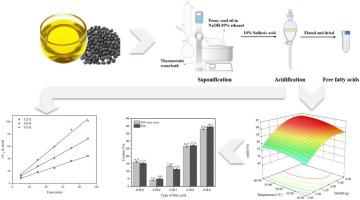Industrial Crops and Products ( IF 5.6 ) Pub Date : 2021-10-07 , DOI: 10.1016/j.indcrop.2021.114134 Mingyang Zan 1 , Xue Wang 1 , Aibibai Amuti 1 , Zhanzhong Wang 1 , Leping Dang 1

|
Peony (Paeonia suffruticosa Andr.) seed oil (PSO) is considered as a new edible oil resource in China, which is rich in α-linolenic acid (ALA). Saponification reaction of PSO was the first step to improve comprehensive utilization of PSO. In this work, Box–Behnken design (BBD) and response surface methodology (RSM) were adopted to optimize the three main influencing factors of dosage of NaOH, reaction time and reaction temperature. The optimized yield (93.6 %) was recorded with the following conditions: 5.5 g of NaOH, 1.6 h of reaction time, and 57 °C of reaction temperature (for 20 g PSO). The model can be successful in predicting the highest yield within the range of experimental variables. By combining elementary reaction principle and the Arrhenius equation, the activation energy (88.473 KJ/mol), the pre-exponential factor (2.763 × 1014 m3/kmol∙min), and the kinetic equation of the PSO saponification reaction were obtained. This work not only enhanced the yield and reduced the raw material consumption of PSO saponification reaction, but also unveiled the equational relationship among reaction rate, reaction time and reactant concentration, which can be useful in industrial production of PSO fatty acid products.











































 京公网安备 11010802027423号
京公网安备 11010802027423号